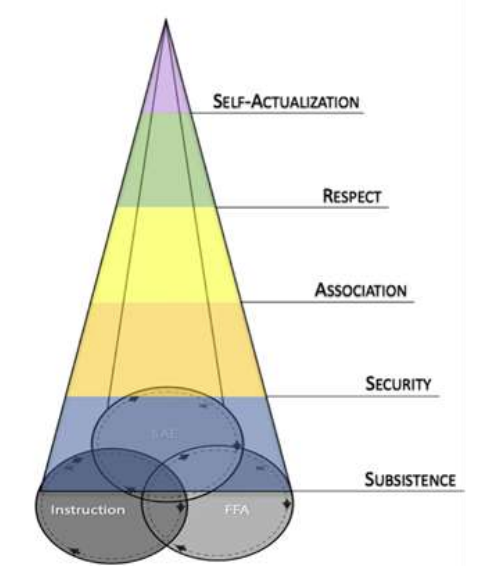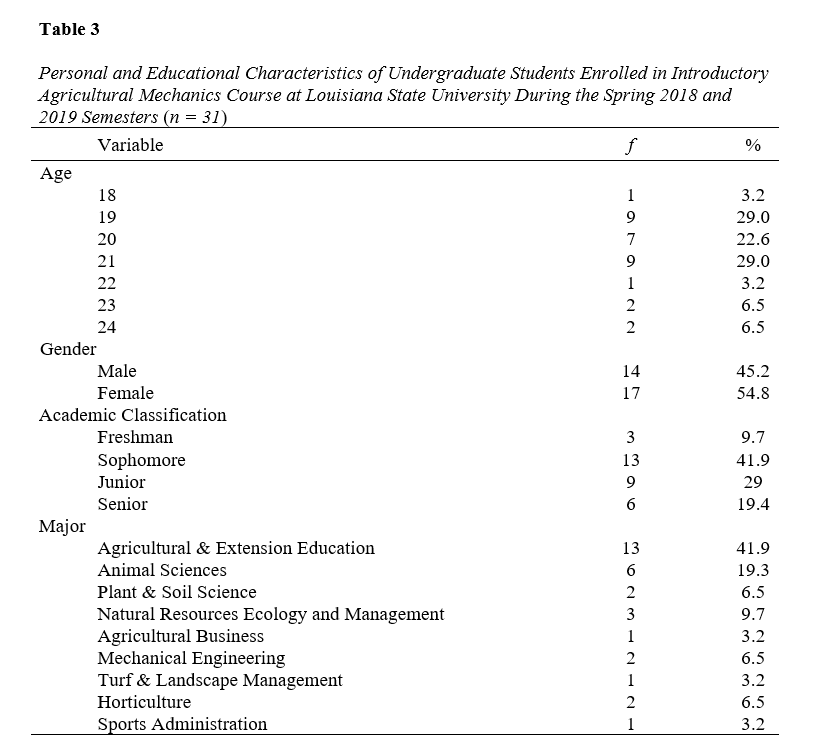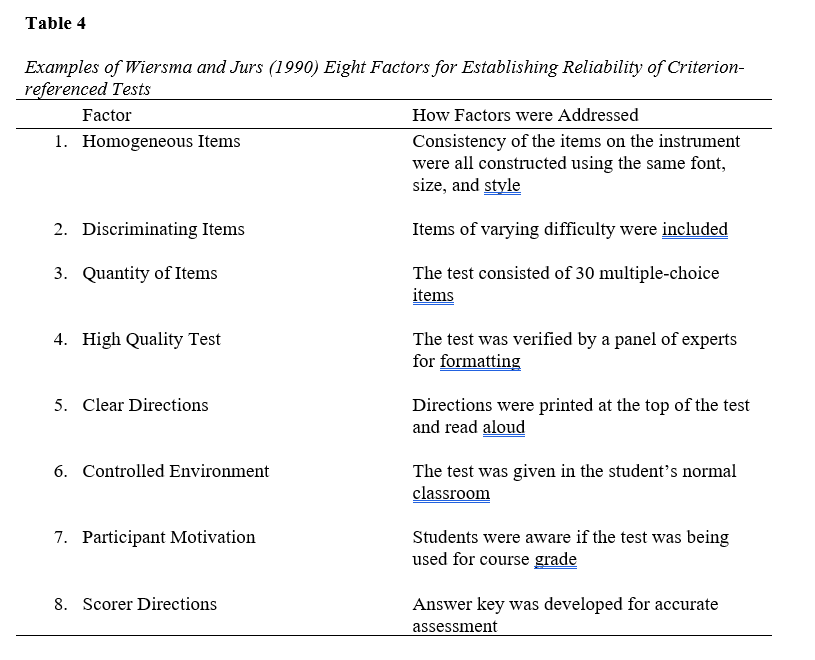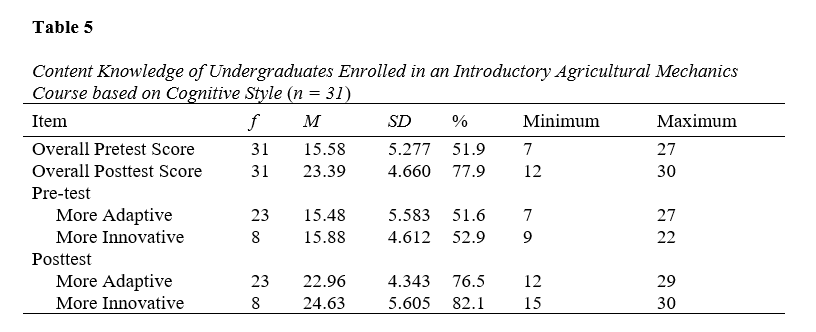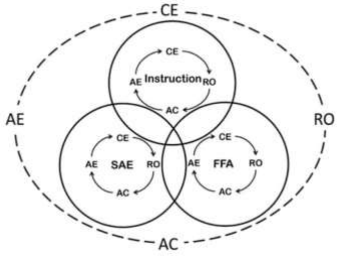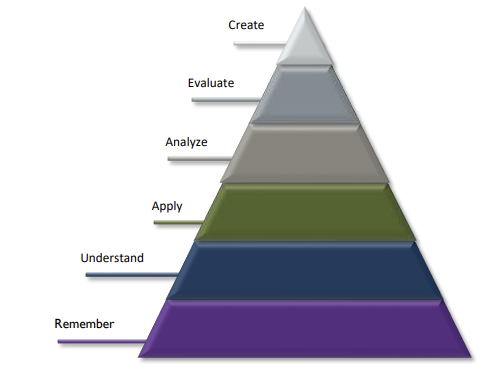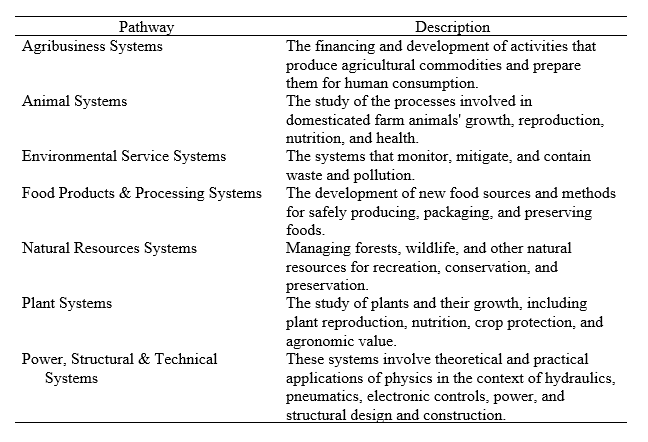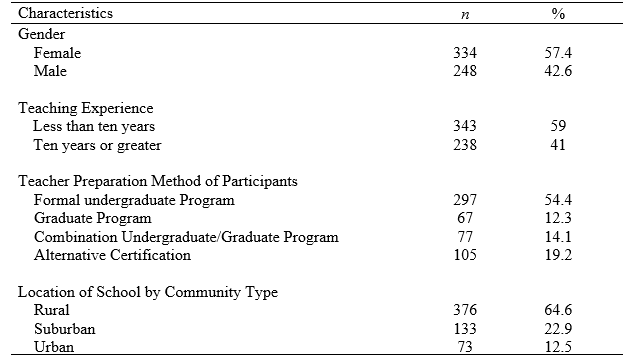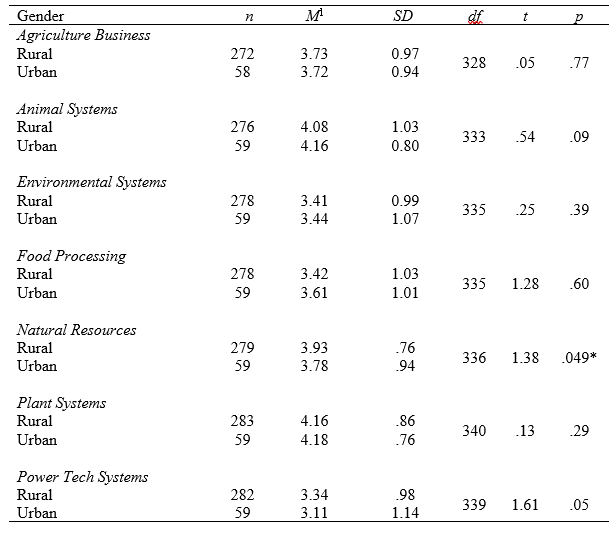Tyler J. Price, Oklahoma State University, tyler.price10@okstate.edu
Emily O. Manuel, Oklahoma State University, emily.manuel@okstate.edu
Emily A. Sewell, Oklahoma State University, easewel@okstate.edu
J. Shane Robinson, Oklahoma State University, shane.robinson@okstate.edu
Abstract
An increased emphasis has been placed on teaching financial literacy at the secondary school level. As such, SBAE teachers have a unique opportunity to teach students about maintaining records and managing data through the Agricultural Experience Tracker (AET). AET has been used nationwide by SBAE teachers to teach students how to manage finances and maintain proper records. The purpose of the study was to describe the self-perceived and actual efficacy of preservice SBAE teachers toward operating and managing student projects through AET. Forty-two preservice SBAE teachers from Oklahoma State University were instructed in the use of AET. The study measured the students’ perceived self-efficacy to use AET at three points during the 16-week semester. Results showed that students’ self-perceived and actual abilities to use AET increased across all areas throughout the semester. However, although their actual ability to use Financial Applications in AET increased across all three observations, their mean scores were still below a 60%, indicating a failing grade. The state office of career and technical education in Oklahoma should be alerted to the actual competency and self-efficacy levels of the new teachers in the state so that appropriate professional development may be provided once these students enter the teaching ranks.
Introduction
Debate exists on whether financial literacy should be taught as a stand-alone course or by integrating it into other curricular areas (Totenhagen et al., 2015). Financial literacy is a critical aspect of being a productive member of society in a culture that requires fiscal responsibility to be self-sufficient (Shim et al., 2009). Therefore, it is imperative that adolescents learn about financial matters to prepare them for the transition to adulthood (Shim et al., 2009). The increased interest in teaching financial literacy in U.S. schools has been on the uprise since the 1990s (Walstad et al., 2010). What is understood about financial literacy is that educators should provide opportunities for students to invest their own money, make decisions, and apply concepts related to managing it appropriately, and at minimum should include course topics such as budgeting, saving, and investing, as well as understanding credit and how it is generated (Totenhagen et al., 2015). Parents, schools, and entrepreneurs should create partnerships that are dedicated to teaching youth sound financial practices (Shim et al., 2009). Walstad et al. (2010) identified that a properly implemented program designed to increase financial literacy can significantly impact the knowledge of high school students regarding their finances. The use of simulation-based learning methods has also shown to be a powerful educational intervention that creates environments conducive to student learning (Warren et al., 2016). Levant et al. (2016) posited that business simulations have the potential to benefit all students regardless of gender identities, cultural backgrounds, and previous experiences. Such simulations have shown promise in school-based agricultural education (SBAE) programs. Brown and Knobloch (2022) identified that the use of simulation by SBAE teachers to teach business management skills was better at increasing students’ financial literacy compared to playing a game about business management.
SBAE provides opportunities for students to manage data and maintain records on their agricultural enterprises and projects. In fact, The National Council for Agricultural Education (2011) found the topic so important they included personal financial planning and management as a mandate for each Foundational Supervised Agricultural Experience (SAE) for students. The goal of the National Council for Agricultural Education (2011) was to have 100% SAE engagement among students. A project known as SAE for All was developed to serve as a resource for SBAE teachers to use in their classrooms due to the need to help students acquire financial planning and management skills through their SAEs (The National Council for Agricultural Education, 2011). In addition to adding financial planning as a mandate for SAE projects, the National Council for Agricultural Education’s (2015) revision of the National Agriculture Food and Natural Resources (AFNR) Content Standards included adding the management of personal finances to the Career Ready Practices content standards. Even so, teaching financial literacy to students has been, and continues to be, a difficult proposition for SBAE teachers (Foster, 1986; Layfield & Dobbins, 2002; Miller & Scheid, 1984; Sorensen et al., 2014; Toombs et al., 2020).
One issue related to teaching financial literacy in SBAE has been the lack of emphasis placed on teaching it, as it remains a high inservice need of all teachers (Sorensen et al., 2014). Part of being an effective teacher is having the appropriate content and pedagogical knowledge necessary to effect student learning (Goodnough & Hung, 2008). Fortunately, teacher preparation programs can positively impact SBAE teachers’ ability to teach specific content (Rice & Kitchel, 2015). Teacher preparation programs are fundamental to teachers’ pedagogical content knowledge (Rice & Kitchel, 2015). For this study, understanding preservice SBAE teachers’ experience using AET can help us identify their perceived self-efficacy using the software, which is imperative to enhancing the interests of students in entrepreneurship and business management and increasing their financial literacy (Brown & Knobloch, 2022).
AET
The AET program was released in 2007 as a data management system designed to assist SBAE instructors teach aspects of record keeping to students regarding their SAEs (The Agricultural Experience Tracker, 2017). Although numerous states have adopted AET as their primary data management system for FFA members, research continues to point to the fact that teachers are ill equipped for using it appropriately and need professional development (Ferand et al., 2020; Sorensen et al., 2014; Toombs et al., 2022). According to Aviles (2015), SBAE teachers found AET to be too complex and time consuming. Sorensen et al. (2014) found AET was one of the highest in-service needs of both early-career (i.e., those with less than six years of experience) and experienced agricultural education teachers (i.e., those with six or more years of experience) in Oregon. What is more, research has indicated that preservice teachers have a low amount of overall self-efficacy related to managing the financial data aspect (i.e., record books) of their students’ SAEs (Toombs et al., 2022), signifying a need for further inquiry in this field. As an interactive software for record keeping, Totenhagen et al. (2015) and Brown and Knobloch (2022) posited that the use of interactive learning experiences and curriculum integration are the best methods for delivering financial literacy content to students. Activities in AET such as the Personal Finance Lab, Practice AET Curriculum, and Agribusiness Management Resources provide SBAE teachers with the tools needed to teach financial literacy (AET, 2023b). Additionally, AET provides SBAE teachers with specific tools to assist in managing their chapter’s activities and students’ projects (AET, 2023a).
AET has been used nationwide by SBAE teachers and students to assist in the acquisition of record keeping skills in time and finance (Hanagriff, 2022). In 2021, more than 8,000 SBAE and FFA programs and 1.1 million SBAE students used AET to assist in tracking Supervised Agricultural Experiences (SAEs), recording FFA activities, and creating and managing FFA award applications (Hanagriff, 2022). AET aligns with the three-circle model of agricultural education and was supported through the use of Perkins and state-curricular funding (The AET, 2023a). As a result, AET has been adopted by 91% of all SBAE and FFA Programs across the U.S. (Hanagriff, 2022). As such, it was recommended that teacher preparation programs prepare teachers to use resources, such as AET, to meet the goals of their students. The suggestion is imperative, as all teachers should be trained on how to access curricular resources and how to evaluate them for use with their students (Mercier, 2015). Despite the widespread adoption of AET by SBAE teachers across the country, little research existed regarding preservice teachers’ self-efficacy for using it. Additionally, research assessing teacher preparation programs’ ability to effectively prepare preservice teachers to instruct students in AET has been largely left out of the cannon of agricultural education research. With the heavy expectation to integrate AET into SBAE programs, what impact can a semester-long course have on students’ self-perceived and actual abilities to use it?
Theoretical Framework
Bandura’s (1977) self-efficacy theory guided the study. Self-efficacy is the belief a person has in his or her ability to perform a specific task or tasks (Bandura, 1977). It is advanced through the repetition of completing the task with the assistance of a mentor. Self-efficacy can increase with a person’s successes and decrease with their failures to complete the task (Wilson et al., 2020) and is largely dependent on an individual’s continual effort, devotion, and behavior toward completing the task (Walumbwa et al., 2011). Four sources impact a person’s self-efficacy (Bandura, 1994). These sources include mastery experiences, psychological arousal, vicarious experiences, and verbal persuasion. Mastery experiences provide the greatest opportunity for increased self-efficacy when individuals succeed at, or accomplish, a task. Vicarious experiences aid in improving self-efficacy when individuals are involved in the experience of observing others (i.e., models) successfully complete a task. Verbal persuasion is produced through encouragement and occurs when individuals are told they “. . . have what it takes to succeed” (Bandura, 1994, p. 3). Physiological arousal is related to how individuals react to the situations they encounter (Bandura, 1994). With the need to increase financial literacy among students across the U.S. school system, and the role SBAE teachers can play in creating such authentic learning opportunities and experiences, it was important to assess students who aspire to be SBAE teachers on their self-perceived and actual abilities to use AET.
Background of the Study, Purpose, and Objectives
Preservice students enroll in AGED 3203: Advising Agricultural Student Organizations and Supervising Experiential Learning during their junior year where they learn about various aspects of FFA and SAE. The course included laboratories where students engage with all aspects of the program, such as advising a local FFA Chapter, supervising student projects, and managing data through AET, as students log entries, produce reports, and complete award applications from fictitious data sets. These experiences were designed to prepare students for their future expectations as SBAE teachers once they enter the academy. As such, AGED 3203 sought to improve student knowledge and experiences related to financial literacy and data management using AET. The course description was as follows:
This course is designed to determine the resources and trends of local communities with respect to agricultural production and agribusiness. Emphasis will be placed on agricultural education program policies, FFA chapter advisement, planning and managing the instructional program, and the identification and completion of records and reports required of a teacher of agricultural education in Oklahoma. (Robinson, 2022, p. 1)
The larger aim of the course was to prepare preservice teachers for implementing effective FFA and SAE programs at the secondary school level. Such preparation includes teaching students to use AET to track their data in hopes of becoming financially literate. To do so, preservice teachers must feel efficacious at using AET. Yet, research has indicated that some people tend to overestimate their efficacy (Woolfolk Hoy & Spero, 2005). It may be possible others underestimate their efficacy. To support such a claim, Robinson and Edwards (2012) assessed the teaching self-efficacy of first-year traditionally and alternatively certified SBAE teachers. They found that traditionally certified teachers consistently outperformed their alternatively certified teaching counterparts when assessed by a third-party observer. Although their actual performance indicators were significantly higher statistically, their self-perceived ratings were lower when compared to their alternatively certified peers. We attributed this difference to the fact that alternatively certified teachers had not been prepared in pedagogy and as such did not know what they did not know about teaching (Robinson & Edwards, 2012). Therefore, this study sought to explore the self-perceived and actual efficacy of preservice SBAE teachers toward operating and managing student projects through AET. The study was guided by the following research objectives:
- Describe the personal characteristics of students enrolled in the course,
- Describe the perceived self-efficacy of preservice SBAE teachers to use AET for managing student projects; and
- Describe the abilities of preservice SBAE teachers to use and advise students in AET.
Methods
The study was approved by the Oklahoma State University (OSU) Institutional Review Board (IRB) on January 26, 2022. This manuscript was based on data presented at the meeting of the Southern Association of Agricultural Scientists (Blinded Authors, 2023). All students (N = 42) enrolled in the junior-levelAGED 3203 at OSU during Spring 2022 were invited to participate in the study. Participation in the study was voluntary and students’ final grade was not affected by their consent to participate or not. Links to the questionnaire were made accessible to the students through the Canvas learning management system for one class day for students to complete. The use of classroom announcements and text reminders were used to recruit participants.
Three points of data were collected. The first data collection point (n = 41) occurred Week 1, the second (n = 41) occurred Week 8, and the third (n = 32) occurred Week 16 (the beginning, middle, and end of the semester). Students completed a questionnaire using Qualtrics regarding their perceived self-efficacy for using AET along with three AET Quizizz assessments.
The questionnaire included personal characteristic questions and 22 statements regarding their perceived self-efficacy to perform various competencies in AET. Each competency statement was rated on a 5-point, Likert-type scale ranging from 1= Strongly Disagreeto 5 =Strongly Agree. Statements were derived from AET Quizizz assessments. Twenty-two complementary statements were developed to determine the perceived self-efficacy of the participants when using AET. For example, one question on the Quizizz asked, “As an FFA officer, where do you record your officer meetings and chapter meetings?” The complementary perceived self-efficacy statement was “Log FFA Activities.” Another Quizizz example was, “After logging into your AET, (blank) should be completed 100% before beginning any other entries.” The complementary perceived self-efficacy statement was, “Create a student AET profile.”
After completing the questionnaire to measure their perceived self-efficacy, the participants then completed three AET Quizizz assessments to measure their actual self-efficacy. The three AET Quizizz assessments addressed student knowledge of AET icons, financial applications, and record book terms. The questionnaire and three assessments were all taken at each data collection point – Weeks 1, 8, and 16.
Face and content validity were assessed by a panel of five experts. In total, our panel possessed 17 years of secondary agricultural education teaching experience, and 23 years of postsecondary agricultural education teaching experience. Further, four of the five members have used AET as secondary agricultural education teachers, and all five currently teach preservice teachers to use AET. A pilot study was not conducted; therefore, we admit that reliability was a limitation of the study. However, the items we used in the Quizziz were taken verbatim from the AET. As such, we chose to treat the reliability as being criterion-referenced (CRT). Because the test followed the eight methods of reliability for a CRT, according to Wiersma and Jurs (1990), we deemed the study reliable.
Descriptive statistics, including central modes of tendency (means and standard deviations) and variability (frequencies and percentages), were used to analyze the data. Personal characteristics included student type (traditional four-year or transfer), FFA degree(s) obtained, FFA office(s) held, and years of FFA experience. Student perception data were analyzed by recording the mean and standard deviation for the group at each of the three data collection points. The change in mean scores between observations one and three were calculated to determine the change in perceptions from the beginning to end of the semester.
Results/Findings
Objective one sought to describe the personal characteristics of the students enrolled in AGED 3203. The personal characteristics of the students are presented in Table 1. One-half (f = 21) were traditional, four-year students with the other one-half (f = 20) being transfer students. Thirty-six (85.71%) of the students had received their Greenhand FFA Degree, and 16 (38.10%) had received their American FFA Degree. Thirty-two (76.19%) had served as a Chapter FFA Officer, two (4.76%) had served as a District FFA Officer, and three (7.14%) had served as a State FFA Officer. Seven (16.67%) had been a State Proficiency Finalist while 19 (45.24%) had been an FFA member for five years, and 15 (35.71%) had been a FFA member for four years (see Table 1).
Table 1
Personal and Professional Characteristics of Participants (N = 42)
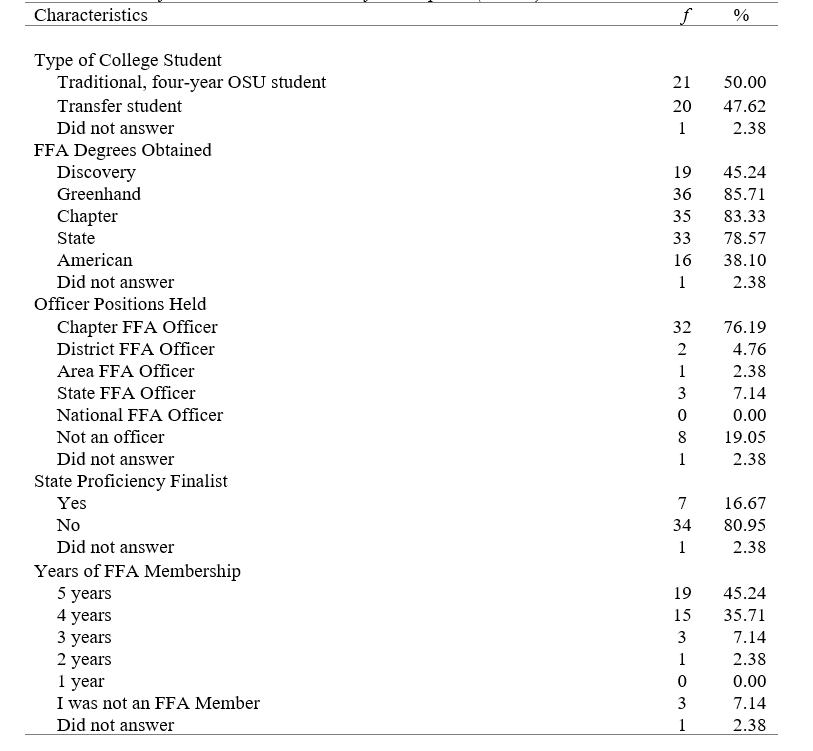
Objective two sought to describe the perceived self-efficacy of preservice SBAE teachers to use AET for managing student projects. Mean scores were compared across observations. To determine overall change of students’ self-perceived efficacy in AET, mean difference (MD) scores were computed by subtracting the mean score in Data Collection 1 from the mean score in Data Collection 3 (see Table 2). In all, student perceptions ranged from the real limits of disagree to agree on all statements in Data Collection 1 and increased from neither agree or disagree to strongly agree in Data Collection 3.
Table 2
Perceived Self-Efficacy of Students (N = 42)

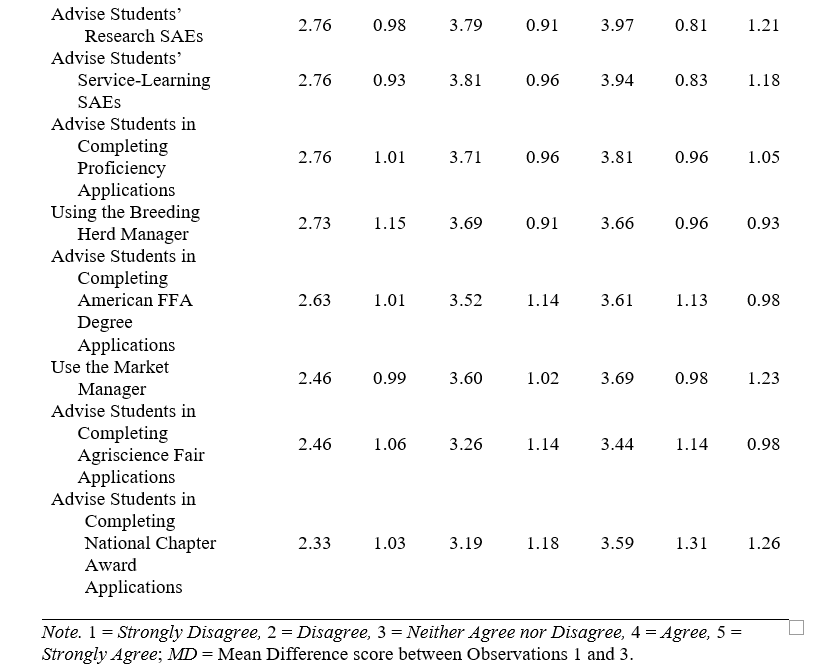
The highest mean score for students in Data Collection 1 was Log FFA Activities (M = 3.71, SD = 0.89), followed by Enter Journal Entries (M = 3.68, SD = 0.92), and Enter Financial Entries (M = 3.66, SD = 0.90). Advise students in Completing National Chapter Award Applications (M = 2.33, SD = 1.03) was the statement that had the lowest mean score for Data Collection 1 (see Table 2).
Regarding Data Collection 2, Enter Journal Entries (M = 4.36, SD = 0.61) had the largest mean score, followed by Enter Financial Entries (M = 4.29, SD = 0.76), and Create a Student AET Profile (M = 4.26, SD = 0.62). Advise Students in Completing National Chapter Award Applications (M = 3.19, SD = 1.18) was the statement that had the lowest mean score of Data Collection 2 (see Table 2).
Regarding Data Collection 3, Enter Journal Entries (M = 4.53, SD = 0.56) had the largest mean score, followed by Log FFA Activities (M = 4.34, SD = 0.59), and Enter Financial Entries (M = 4.25, SD = 0.83). Advise students in Completing National Chapter Award Applications (M = 3.59, SD = 1.31) was the statement that had the lowest mean score of Data Collection 3 (see Table 2).
Students experienced the greatest amount of perceived growth in the areas of National Chapter Award Applications (MD = 1.26), Use the Market Manager (MD = 1.23), and Advise Students’ Research SAEs (MD = 1.21). The least amount of perceived growth occurred in the ability to use AET to Log Community Service Activities (MD = 0.58), Enter Financial Entries (MD = 0.59), and Create a Student AET Profile (MD = 0.60). All statements experienced a positive increase in student self-efficacy mean scores from Data Collection 1 to Data Collection 2. The majority of the statements also experienced an increase from Data Collection 2 to Data Collection 3. However, Enter Financial Entries, Create a Student AET Profile, and Using the Breeding Herd Manager all experienced slight decreases in mean scores from Data Collection 2 to Data Collection 3, but these values were still greater than their mean scores detected in Data Collection 1 (see Table 2).
Objective three sought to determine students’ actual ability to identify features and use AET as a curricular resource for SAEs across the semester. The AET Quizizz were used to measure student knowledge of the data management program. Mean scores were compared across observations for each assessment as well as cumulatively (see Table 3).
Table 3
Actual Ability of Participants to Identify and Use Features within AET (N = 42)

At the time of Data Collection 1 students had a cumulative score of 57.40 (see Table 3). Regarding the quiz components, they collectively scored 62.20 on the Record Book Terms, 57.07 on AET Icons, and 55.80 on Financial Applications.
During Data Collection 2, students increased their cumulative score to a 65.93 (see Table 3). In the individual quiz areas, participants scored 74.86 on the Record Book Terms, 70.48 on the AET Icons, and 57.19 on the Financial Applications.
During Data Collection 3, students had a cumulative score of 65.02 (see Table 3). For the quiz components, they scored 69.49 on the Record Book Terms, 69.20 on the AET Icons, and 59.10 on the Financial Applications.
Students’ actual knowledge of AET Icons, Financial Applications, and Record Book Terms increased between Observations 1 and 2, with Record Book Terms and AET Icons both increasing by more than ten percent. However, during Data Collection 3, Record Book Terms and AET Icons exhibited a decrease in students’ actual ability to recall terms and identify icons. Although slight, actual ability to determine correct Financial Applications increased throughout all three observations. Cumulatively, students’ actual ability to use AET increased from Data Collection 1 to Data Collection 2, and then slightly decreased when evaluated in Data Collection 3. The greatest growth of AET Quiz Components from Week 1 to Week 16 was realized for AET Icons (MD = 12.13). In comparison, Financial Applications experienced the least amount of change (MD = 3.30) in students’ actual ability throughout the semester-long course experience.
Conclusions
Students failed to reach a level mastery of using AET Financial Applications across the 16-week instruction period.Although students’ actual ability to determine Financial Applications in AET increased across the three observations, their mean scores were still below a 60%, indicating a failing grade. Unfortunately, students were only able to increase their overall knowledge of AET by a total of eight and one-half points (a grade of D) from Week 1 to Week 16. Simply stated, participants were not proficient in the financial applications of AET, which is concerning considering the importance of teaching financial literacy in the current climate (Totenhagen et al., 2015). These results also showed that students were not able to master a core piece of the course’s purpose which was to identify and complete records and reports required of SBAE teachers using programs required in Oklahoma (Robinson, 2022). In addition to failing to meet the purpose of the course, these scores also show that many of the participants were unable to appropriately use AET as a chapter management tool (AET, 2023a). These poor scores were also concerning as fewer states look to add economics and personal finance courses to their graduation requirements (CEE, 2022). These findings also support those of Aviles (2015) who found that the areas of financial applications were areas where many struggled when utilizing the tools of AET.
Roughly one-half of the students began their undergraduate education at OSU. Three (7%) students were not FFA members in high school. In addition, 21% of the students did not receive their State FFA Degree, and only 17% had been a finalist for a State FFA Proficiency Award. Therefore, it is possible that a high number of students failed to have adequate experience with AET as high school students prior to this course. As such, it might be unfair to expect these students to obtain mastery (Bandura, 1994) in AET after one class. In addition, this lack of experience in the use of AET could have an impact on pedagogical content knowledge specifically (Rice & Kitchel, 2015).
Students’ self-perceived abilities to use AET increased across all areas throughout the semester, which supports Bandura’s (1977) assertion that self-efficacy is solidified through rich experiences of performing a particular task over time. Increases were detected across the semester in all 22 statements, indicating that the students improved their efficacy for using the software and advising student SAEs because of the course. The term Advising Students in Completing National Chapter Award Applications was rated lowest in self-perceived ability by students in all three observations. However, it was also the statement that experienced the greatest amount of overall mean difference change throughout the semester.
Students’ actual abilities also increased overall when compared across the three-point time series; however, the growth might not be sustained long term, as scores showed a decrease between observations two and three in comparison to those noted between observations one and two. It is possible that the results might be attributed to the timing of the presentation of content related to AET. Specifically, aspects of AET were emphasized heavily during the first one-half (eight weeks) of the semester, and then tapered off toward the end of the semester. The more elevated scores detected from Data Collection 1 to Data Collection 2 may be due to the recency effect of the emphasis of AET during that time frame.
Recommendations
The study was limited to the delivery of AET content and generalizability of its results. An assumption was made that the same content and activities featuring AET would be taught and implemented each week by the three teaching assistants charged with delivering content to their respective laboratories. Although weekly meetings were held throughout the semester to attempt to maintain fidelity and consistency of such, differences in teaching assistants’ personalities, teaching styles, and experiences using AET as former SBAE teachers themselves undoubtedly existed and could have impacted the study’s findings. participants’ prior experience in AET was not collected, and their experience may have impacted the findings. Therefore, we acknowledge the results of the study could be limited by these factors. Moreover, the study included a convenient sample of students enrolled in a required teacher preparation course offered at the junior level at one institution.
Given the results cannot be generalized to all preservice SBAE teachers across the country, it is recommended additional research on the self-efficacy and actual ability of preservice teachers to implement AET is conducted with a larger population of preservice teachers. We recommend other preservice institutions replicate this study to determine if the findings hold true across other university settings. We also recommend that correlational studies ensue to assess students’ abilities to effectively use AET based on their involvement in FFA activities at the secondary school level. Further research also should investigate whether the use of AET does in fact increase financial literacy. It is recommended that a financial literacy assessment be used to determine if the use of AET, SBAE’s version of a simulation-based method, improved financial literacy of the participants (Levant et al., 2016). These future studies should identify the effectiveness of the training resources provided by AET to instruct students in proper data management and record keeping strategies.
Regarding the course content, students need additional experience with the statement: Advising students in completing National Chapter Award Applications, as students consistently rated it as the lowest mean value in each of the three observations. Perhaps the reason for this poor rating was due to students not currently having the opportunity to work with actual data from FFA members. Students be paired with a mentor teacher and FFA members in SBAE programs so that they can experience a richer connection to AET and obtain real-world experience with advising students who are working on award applications as part of their SAE program. Providing dedicated time for students in this course to interact with FFA members while using AET would likely increase their readiness to learn and afford concrete experiences for preservice teachers to learn the content while using actual student data and working with a mentor teacher.
Further, it was important to determine the impact of this preparation on students as they enter the teaching profession. Are they better prepared for integrating AET into their classrooms and FFA programs having learned about and used it for multiple weeks as part of their preservice preparation? Or, is readiness to learn the criterion absent or minimized during this phase of their preparation? Regardless, AET should be a point of emphasis during the student teaching internship and again, as professional development, after students have accepted positions during their first year of teaching. Conducting a longitudinal trend study would provide comparisons between perceived and actual self-efficacy of teachers based on actual projects and experiences of their students and their readiness to learn such content. Finally, regarding teaching styles of graduate teaching assistants, a quasi-experimental study should be conducted in which different pedagogies are used to instruct students in the use of AET. A comparison of such across different laboratory settings could aid in identifying the most effective method of instruction for teaching students the importance of using AET and how to do so most effectively. Regarding states that do not use or require AET in the agricultural education program, it was recommended that a similar study be conducted to understand the perceived and actual self-efficacy of preservice SBAE teachers in using the software used within that state.
Discussion
The most effective ways of teaching young people to become financially independent, literate, and to make good investment decisions is an important topic that should continue to be discussed and considered by SBAE teachers. The current study provides additional insight into the practice of preparing SBAE teachers. The timing of when to teach certain topics to students is an imperative task for all teacher preparation programs. Perhaps students simply were not ready to learn all aspects of AET during the spring semester of their junior year. Based on the findings of this study, it is imperative that we, as a teacher preparation program, implement aspects of AET into other preservice courses, where appropriate, to provide students additional opportunities and iterations necessary for mastery experiences (Bandura, 1994). It is possible the students in this study experienced the largest growth in mean difference of perceived ability to complete National Chapter Award applications because of a project where they plan out mock events. Therefore, growth is observed in the preservice courses where opportunities to learn through doing is possible. In addition, regarding the practice of teaching SBAE, the state office of career and technical education in Oklahoma should be alerted to the actual competency and self-efficacy levels of the new teachers in the state so that appropriate professional development may be provided once these students enter the teaching ranks. Finally, it is entirely possible that students overestimate their abilities to perform certain tasks (Woolfolk Hoy & Spero, 2005), especially when interfacing with that content over the course of a semester. Therefore, it is necessary that continued follow-up training and support exist to ensure that perceived self-efficacy eventually leads to actual competence.
References
Aviles, H. A. (2015). An examination of Oklahoma agricultural educators’ innovativeness and perception regarding the mandated adoption of the agricultural experience tracker. [Master’s thesis, University]. ProQuest. https://www.proquest.com/dissertations-theses/examination-oklahoma-agricultural-educators/docview/1965469087/se-2
Bandura, A. (1994). Self-efficacy. In V. S. Ramachaudran (Ed.), Encyclopedia of human behavior, 4, 71–81.
Bandura, A. (1977). Self-efficacy: Toward a unifying theory of behavioral change. Psychological Review, 84(2), 191–215. https://doi.org/10.1037/0033-295X.84.2.191
Brown, A. H., & Knobloch, N. A. (2022). Effects of a simulation on eight grade students’ management knowledge and entrepreneurial intent in an exploratory agriculture course. Journal of Agricultural Education, 63(1), 88–101. https://doi.org/10.5032/jae.2022.02088
Council for Economic Education (CEE). (2022). CEE’s 2022 survey of the states. https://www.councilforeconed.org/survey-of-the-states/
Ferand, N. K., Thoron, A. C., & Myers, B. E. (2020). The relationship of prior FFA membership on perceived ability to manage an FFA chapter. Journal of Agricultural Education, 61(2), 162–172. https://doi.10.5032/jae.2020.02162
Foster, R. M. (1986). Factors limiting vocational agriculture student participation in supervised occupational experience programs in Nebraska. Journal of the American Association of Teacher Educators in Agriculture, 27(4), 45–50. https://doi.org/10.5032/jaatea.1986.04045
Goodnough, K. C., & Hung, W. (2008) Engaging teachers’ pedagogical content knowledge: Adopting a nine-step problem-based learning model. Interdisciplinary Journal of Problem-Based Learning, 2(2), 61–90. https://doi.org/10.7771/1541-5015.1082
Hanagriff, R. (2022). 2021 agricultural education engagement executive summary report. https://theaet.com/docs/2021%20COMBINED%20Agricultural%20education%20Values%20(8.25%20×%2011.5%20in)%20(2).pdf
Layfield, K. D., & Dobbins, T. R. (2002). Inservice needs and perceived competencies of South Carolina agriculture teachers. Journal of Agricultural Education, 43(4), 46–55. https://doi.org/10.5032/jae.2002.04046
Levant, Y., Coulmont, M., & Raluca, S. (2016). Business simulation as an active learning activity for developing soft skills. Accounting Education, 25(4), 368–395. https://dx.doi.org/10.1080/09639284.2016.1191272
Mercier, S. (July, 2015). Food and agricultural education in the United States. AGree Transforming Food & Ag Policy Report.
Miller, W. M., & Scheid, C. L. (1984). Problems of beginning teachers of vocational agriculture in Iowa. Journal of the American Association of Teacher Educators in Agriculture, 25(4), 2–7. https://doi.org/10.5032/jaatea.1984.04002
Robinson, J. S. (Spring 2022). AGED 3203: Advising agricultural student organizations and supervising experiential learning [Syllabus]. Department of Agricultural Education, Communications, and Leadership. Oklahoma State University.
Sorensen, T. J., Lambert, M. D., & McKim, A. J. (2014). Examining Oregon agriculture teachers’ professional development needs by career phase. Journal of Agricultural Education, 55(5), 140–154. https://doi.org/10.5032/jae.2014.05140
The Agricultural Experience Tracker. (2017). Agricultural education online recordkeeping system. Author. https://www.theaet.com
The Agricultural Experience Tracker. (2023a). What is AET? Author. https://theaet.com/WhatIsAET
The Agricultural Experience Tracker. (2023b). AET in the classroom. Author. https://theaet.com/ClassroomResources
The National Council for Agricultural Education (2015). Career ready practices. https://ffa.app.box.com/s/n6jfkamfof0spttqjvhddzolyevpo3qn/file/294154473359
The National Council for Agricultural Education (2011). Supervised agricultural experience (SAE) philosophy and guiding principles. https://thecouncil.ffa.org/sae/
Thorton, K., E., Easterly, R. G., III., & Simpson, K. A. (2020). Curricular resource use and the relationship with teacher self-efficacy among New Mexico school-based agricultural education teachers. Journal of Agricultural Education, 61(4), 343–357. https://doi.org/10.5032/jae.2020.04343
Toombs, J. M., Eck, C. J., & Robinson, J. S. (2022). The impact of a project-based learning experience on the SAE self-efficacy of pre-service teachers. Journal of Agricultural Education, 63(1), 29–46. https://doi.org/10.5032/jae.2022.01029
Totenhagen, C. J., Casper, D. M., Faber, K. M., Bosch, L. A., Wiggs, C. B., Borden, L. M. (2015). Youth financial literacy: A review of key considerations and promising delivery methods. Journal of Family and Economic Issues, 36, 167–191. https://doi.org/10.1007/s10834-014-9397-0
Walstad, W. B, Rebeck, K., & MacDonald, R. A. (2010). The effects of financial education on the financial knowledge of high school students. The Journal of Consumer Affairs, 44(2), 337–357. https://doi.org/10.1111/j.1745-6606.2010.01172.x
Walumbwa, F. O., Mayer, D. M., Wang, P., Wang, H., Workman, K., & Christensen, A. L. (2011). Linking ethical leadership to employee performance: The roles of leader-member exchange, self- efficacy, and organizational identification. Organizational Behavior and Human Decision Processes, 115(2), 204–213. https://doi.org/10.1016/j.obhdp.2010.11.002
Warren, J. N., Luctkar-Flude, M., Godfrey, C., & Lukewich, J. (2016). A systematic review of the effectiveness of simulation-based education on satisfaction and learning outcomes in nurse practitioner programs. Nurse Education Today, 46, 99–108. https://doi.org/10.1016/j.nedt.2016.08.023
Wiersma, W., & Jurs, S. G. (1990). Educational measurement and testing (2nd ed.). Allyn and Bacon.
Wilson, C., Woolfson, L. M., & Durkin, K. (2020). School environment and mastery experiences as predictors of teachers’ self-efficacy beliefs towards inclusive teaching. International Journal of Inclusive Education, 24(2), 218–234. https://doi.org/10.1080.13603116. 2018.1455901
Woolfolk Hoy, A., & Spero, R. B. (2005). Changes in teacher efficacy during the early years of teaching: A comparison of four measures. Teaching and Teacher Education, 21(4), 343–356. https://doi.10.1016/j.tate.2005.01.007
